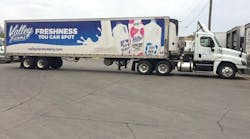While the farm-to-table movement that promotes serving local food has gained momentum in recent years, the concept is nothing new for Upstate Niagara Cooperative Inc. The process of delivering fresh milk from farm to fridge always has been at the core of Upstate Niagara’s focus on offering high quality dairy products.
“It doesn’t take long for our milk to reach store shelves,” said John Dunn, senior distribution manager at Upstate Niagara. “In most cases, within 36 hours of leaving the farm, our milk is processed and either bottled or used in the manufacturing of other dairy products. Once our products are packaged, they can be out the door and in stores the next day.”
Upstate Niagara’s ongoing ability to provide fresh products depends heavily on an efficient and productive transportation operation. Milk that is produced on the cooperative’s more than 300 family-owned dairy farms is picked up daily by dedicated haulers and delivered to one of seven processing facilities. There, it is processed and packaged for a quick turnaround that results in fresher, better tasting products.
The various fleets that operate under the Upstate Niagara banner, which encompasses a number of dairy cooperatives, have a total of more than 300 power units. The majority of the tractors are Volvo models, while the balance consists of Kenworths and Freightliners. Trailers are mainly Great Dane reefers with Thermo King refrigeration units.
Upstate Niagara vehicles cover a mix of highway and local direct store delivery routes. In some cases, a unit may make 20 stops in a 40-mile run; in others, there might be three stops over a more than 550-mile round trip. In other parts of the operation, a tractor may pull a set of tandem 27-foot trailers or a pair of 43-footers in a combination weighing 143,000 pounds.
“All of those configurations, routes and loads mean we need equipment for different jobs,” Dunn related. “We spec powerplants, axles and gearing for different loads based on whether we’re hauling single or double 27-, 35-, 43- or 48-foot trailers. The average long-haul, single trailer combination in our fleet weighs in at 80,000 pounds fully loaded.
“All of that variation makes achieving optimal fuel efficiency a challenge,” he continued, “but we’ve been successful in achieving the best possible mpg. The right powertrain specs and things like automated manual transmissions and idle shutdown timers go a long way toward boosting fuel economy.”
Dunn pointed to the success at Valley Farms specifically. The Williamsport, Pa.-based part of the Upstate Niagara Cooperative provides fresh milk to customers in Pennsylvania and New York. Along with another 150 of Upstate Niagara’s power units, the Valley Farms operation utilizes 46 tractors and 56 trailers equipped with the Vnomics True Fuel optimization solution to reduce fuel consumption.
True Fuel, Dunn explained, establishes a truck’s potential fuel economy independent of route, load and other external factors, and then assists drivers to achieve that full potential through in-vehicle driver coaching. The scoring model includes assessments of driver fuel efficiency in the areas of engine control, speeding and idling. The three key fuel waste behaviors are rolled into a fair and balanced composite GPA-like assessment of the driver’s real-world fuel efficiency performance that is automatically normalized for operating conditions. The Vnomics True Fuel solution is also being used at Valley Farms to provide incentives to drivers based on fuel savings and to foster competition among drivers to save fuel.
“With True Fuel in the entire Valley Farms fleet, which travels 1.3 million miles annually, we’ve seen overall savings of 10% to 12% in lower fuel use,” Dunn reported. “One Valley Farms tractor-trailer driver who covers 300 miles daily making direct store deliveries raised his fuel efficiency score from 88% to 99.99% over 60,000 miles in eight months.
“The savings he generated added up to 1,400 gallons annually,” he added. “Across the entire Upstate Niagara operation, drivers are steadily improving their efficiency scores as well.
“With a distribution operation that includes a reliable fleet, we can get our wide variety of dairy products to customers while they are still as fresh as possible,” Dunn stated. “With the right equipment and technologies, we can transport items from farm to fridge while saving fuel in the process.”



